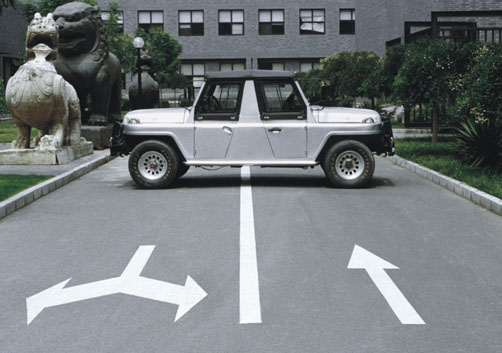Contemporary Chinese Art- another kind of view
DSL Collection
It is boys' nature to be fond of cars, weapons and wild animals, and Li Hui is no exception. In his works, one can find the most popular and fashionable means of transport and fierce ancient beasts. Born in the 1970s, Li Hui started with an academic background but traces of the traditional way of art creating can hardly be detected in his works as they stand out novel in style and unique in expression. He dares to introduce industrial materials and products into his art which lends a flavour of modernism to his works.
Li Hui boldly incorporates his fondness of cars into his creations and experiments. In one of his early installations Remodeled
Jeeps- Going Forwards or Backwards, he tactically joined the fronts of two cars together and created a new vehicle. The idea may sound crazy but Li Hui adventured to carry it out. He cut two cars off in the middle and pieced the two fronts together, to form a complete symmetrical structure with two engines, two steering wheels, two driver's seats, two transmissions and so on. More importantly, the new car can be driven like a real car from either end. Li created not only a piece of art but also a two-headed vehicle. From an artist's perspective, this experimentation is more of his own understanding of the modern world than the act of transforming cars. Li Hui interprets the concept of this new car's heading towards both directions at the same time as the contradiction of modern development, which can be seen both as a foreword and backward movement. When an object is moving, it may be moving forward, it may be falling back because of a previous foreword movement, or it may be going ahead because of a previous backward movement. With this question, we are seeking the truth from both illusionary and real arguments.
In addition to his obsession with cars, Li Hui loves animals. He is concerned with the protective coloration of animals, and
considers it a basic animal instinct in evolution, since changes are necessary for animals to survive their environment and live more securely. Thus he believes that animals in the industrial age should take on corresponding protective colours. A tame creature like a giraffe has a yellowish coat mottled with brown patches which serves as a natural protection. Based on this theme, Li Hui created a giraffe made from metal carvings. He makes us consider whether giraffes should possess the corresponding colours for this industrial age in order to survive it. The work Giraffe - Protective Colour in the Industrial Age is the artist's survey of the current environment, and moreover, a reminder of the issues we need to address and watch out against drastic environmental changes in this industrial era.
Amber, an organic compound derived from coniferous resin plants as a result of geological effects between the Mesozoic and Cenozoic periods, finds its use in Li Hui's art - he transformed it into a combination of transport vehicles and animal bones. In one of his pieces, the body of the vehicle in white amber brings us a brand new concept of car design. Glittering and translucent, reflecting a bluish lustre, the body takes the shape of a large horse skeleton, fully embodying the opposing yet indispensable relationships between life and machinery, the past and the present. Li Hui created a series of several works with the amber theme, including a luminous blue vehicle, and another in the form of a space shuttle. In this piece, a complete set of dinosaur skeleton is revealed within the space shuttle under cold blue lights. Regardless of where it is displayed, this cold, harsh installation never fails to carry the viewer back to times of the distant past. Li's artistic is modern and cutting-edge, giving the viewer a certain yet inexplicable impression that things are lurking in the shadows of human life. The Amber series ingeniously exploits the transparent quality of acrylic, so as to create a more sensual visual experience.
Apart from a series of hard sculptures, Li also created soft installations. Laser, as 'fashionable' form of light from our daily
life, is different from other kinds of light in its projective power and monochromatic colour. A laser beam appears like something we can take hold of, and when watching the beam extend infinitely into space creates an indescribable sense of stimulation. Lights are expressive and demonstrative - you can feel the touch of a light when it is shone onto your face. Li Hui is fascinated by the magic of light and explores different ways of incorporating its spectacular qualities into his works. In his work Cage, a cage is formed by encircling lasers in a limited space - the form of the cage reveals itself in moving dust and mist, while the laser beams divide the space in a real physical sense, or cross the space at will. It offers the viewer an experience of things that not only exist in imagination and myths, but can also appear as real objects in our ordinary lives.
To be perceptive of what is happening in the surroundings, and to research extensively for new materials to create new works - this sums up the attitude held by the young generation of artists, and their basic instinct cultivated from the processes and experience of artistic creation.
It is in the way that Li Hui continues to pursue in his material paradise.
